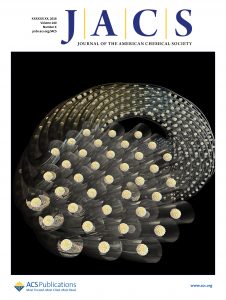Congratulations to Doug and Curtis for publishing their paper in JACS.
Nevers, Douglas R., Curtis B. Williamson, Benjamin H. Savitzky, Ido Hadar, Uri Banin, Lena F. Kourkoutis, Tobias Hanrath, and Richard D. Robinson. “Mesophase Formation Stabilizes High-purity Magic-sized Clusters.” Journal of the American Chemical Society (2018). (https://pubs.acs.org/doi/abs/10.1021/jacs.7b12175)
 Magic-sized clusters (MSCs), which are identical in size and resistant to conventional nanoparticle (NP) growth processes, represent an ideal synthetic product to overcome the complications resulting from the size dispersion (at least 3%) inherent to conventional NP synthesis method. However, fundamental reaction pathways toward their nucleation and stabilization still present many outstanding challenges. Here, we show that our high concentration synthesis accentuates fundamental surfactant mesophase behavior that stabilize and enable isolation of high-purity cadmium sulfide MSCs.
Magic-sized clusters (MSCs), which are identical in size and resistant to conventional nanoparticle (NP) growth processes, represent an ideal synthetic product to overcome the complications resulting from the size dispersion (at least 3%) inherent to conventional NP synthesis method. However, fundamental reaction pathways toward their nucleation and stabilization still present many outstanding challenges. Here, we show that our high concentration synthesis accentuates fundamental surfactant mesophase behavior that stabilize and enable isolation of high-purity cadmium sulfide MSCs.
In this paper we address a fundamental question for MSCs: how does the precursor concentration direct the synthetic pathway between NPs and MSCs? Building upon our recently developed synthesis methods we demonstrate that a crossover in behavior is achieved by tuning concentration: ultra-high concentration synthesis promotes a well-defined reaction pathway to produce high purity MSCs (>99.9%) and forms a mesophase assembly that kinetically arrests the MSCs from NP growth. Using in-situ X-ray scattering, we find that high-purity MSC formation is accompanied by the production of a large hexagonal mesophase assembly (>100 nm grain size), containing thousands of discrete MSCs. At intermediate concentrations the mesophase assembly is less stable, resulting in NP growth at the expense of the large MSC assemblies. Collectively, these findings present an alternative result from the conventional mantra that the stability of MSCs derives from the precise arrangement of the inorganic structures (i.e., closed-shell atomic packing); we demonstrate that disordered, yet distinct, clusters can also be stabilized by self-forming fibrous mesophase assemblies. In this light we evaluate previous MSC studies and suggest that they may have been, unknowingly, observing mesophase formation or surfactant phase behavior coupled with their MSC formation. Overall, we find that the high concentration approach intensifies and showcases inherent concentration-dependent surfactant phase behavior that is not accessible in conventional (i.e., dilute) conditions.
We propose that our high concentration synthesis of MSCs provides not only a robust method to synthesize, stabilize, and study identical NP products, but also demonstrates an underappreciated stabilizing role of surfactants in NP synthesis.

